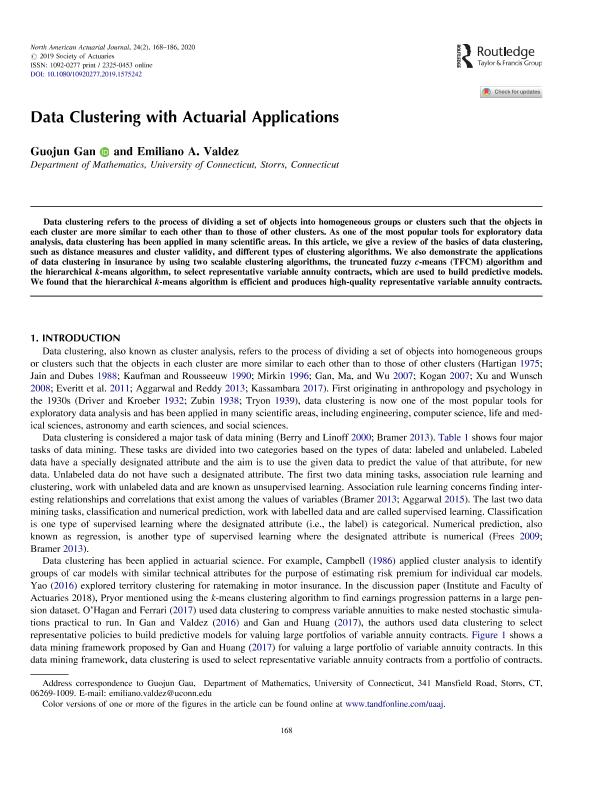Data clustering with actuarial applications

Contenido multimedia no disponible por derechos de autor o por acceso restringido. Contacte con la institución para más información.
| Tag | 1 | 2 | Valor |
|---|---|---|---|
| LDR | 00000cab a2200000 4500 | ||
| 001 | MAP20200018070 | ||
| 003 | MAP | ||
| 005 | 20220911211151.0 | ||
| 008 | 200528e20200526usa|||p |0|||b|eng d | ||
| 040 | $aMAP$bspa$dMAP | ||
| 084 | $a6 | ||
| 100 | 1 | $0MAPA20140000234$aGan, Guojun | |
| 245 | 1 | 0 | $aData clustering with actuarial applications$cGuojun Gan, Emiliano A. Valdez |
| 520 | $aData clustering refers to the process of dividing a set of objects into homogeneous groups or clusters such that the objects in each cluster are more similar to each other than to those of other clusters. As one of the most popular tools for exploratory data analysis, data clustering has been applied in many scientific areas. In this article, we give a review of the basics of data clustering, such as distance measures and cluster validity, and different types of clustering algorithms. We also demonstrate the applications of data clustering in insurance by using two scalable clustering algorithms, the truncated fuzzy c-means (TFCM) algorithm and the hierarchical k-means algorithm, to select representative variable annuity contracts, which are used to build predictive models. We found that the hierarchical k-means algorithm is efficient and produces high-quality representative variable annuity contracts. | ||
| 650 | 4 | $0MAPA20080578848$aAnálisis de datos | |
| 650 | 4 | $0MAPA20080553128$aAlgoritmos | |
| 650 | 4 | $0MAPA20080592059$aModelos predictivos | |
| 650 | 4 | $0MAPA20080602437$aMatemática del seguro | |
| 650 | 4 | $0MAPA20080579258$aCálculo actuarial | |
| 700 | 1 | $0MAPA20080648428$aValdez, Emiliano A. | |
| 773 | 0 | $wMAP20077000239$tNorth American actuarial journal$dSchaumburg : Society of Actuaries, 1997-$x1092-0277$g01/06/2020 Tomo 24 Número 2 - 2020 , p. 168-186 |

